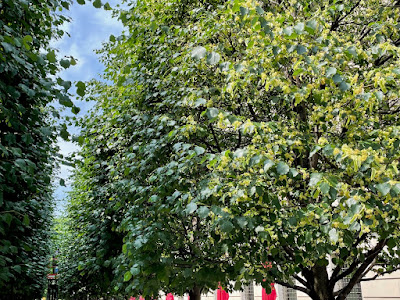When I threw together the course description for "Religion of Trees" I didn't quite know what the course could be about - just that it would be fun, and bring together things students and I are interested in. Now a few weeks into reading more deeply around trees I can feel the course taking a different shape than I'd dimly imagined.
What had I dimly imagined? That we'd look at trees in world religions, noting similarities and differences. Similar would be verticality if not quite Eliade's axis mundi, differences might emerge from comparing world trees and trees of life with the gnarled survivors of Zhuangzi. But all the trees I imagined were sublime - vastly larger or older than human beings, images of transcendence rooted in the depths of the earth and reaching to the sky, sheltering us. (I've yet to scope out the Bodhi tree and if it plays any such role.) We'd turn then to new tree science, perhaps by way of the tree of life in the Book of Revelation, which manages not only to offer all manner of fruits and healing herbs but to be on both sides of a river - a nod toward the subterranean networks and relationship of trees, as Catherine Keller has suggested? The parts of trees our visual imagination fixes on are hardly the most important (emblematic our attachment to leaves which change color just as they cease to serve a purpose for the tree).
I suppose my thinking began to change when I decided the class might incorporate tree drawing, and imagined a sequence of lessons: draw how you imagine a tree, then some actual trees, then some tree architectures, then eventually root systems and forests connected by mycelial webs. Along the way we'd consider how each of these might offer different religious morals. As we became more enmeshed with actual trees we might start learning something from them, perhaps that God is like the "mother tree" of a forest (as Process theologian Jay McDaniel has suggested), perhaps that everything is sentient and so interdependent. Along the way we might notice ways in which we - individually (sic), collectively - are more treelike than we imagined...
But the tree drawing, I discovered on trying my hand at it, is hard! And some of the philosophers and literary folks who write about plants and trees are goofy. While enjoyable, accounts of hearing the voices of trees after a "diet" of tree bark, etc. left me cold. (Must everything be psychedelic?) The more I read the less convinced I was that the myriad and marvelous forms of aborial sentience and communication being revealed by scientists (and ingenious artists) had anything to do with, or to say to, us. Call me a skeptic; part of what speaks to me about trees is that they don't speak to us, or speak (in some very broad sense of the term) but not to us.
Then I happened on William Bryant Logan's Sprout Lands, a work framed by the challenge of pollarding London plane trees in front of the Metropolitan Museum of Art (at top is a picture I took of one of them this morning) and finding nobody to turn to for help. Logan's an arborist and a poet, who thinks the heart most illuminated when in harmony with the hands. His book takes apart the idea that humans have ever had relationships with trees which didn't involve working with them - cutting, pruning, grafting... This was no less true of trees in woods than in orchards or gardens; indeed that contrast falls apart too. Our image of stately trees with clean lines are the result of English post-enclosure ideals. In the new picturesque landscape, man became the spectator of an idea of nature that he himself had made in the image of a primordium that had never existed (29). None of the world's "wild" forests - even the Amazon! - weren't in fact shaped by human beings. Logan suggests we think of woodlands as like lichens, the symbiotic work of trees and humans. Our icon of a tree should be the spray of a copse or the knuckles of pollarded trees.
So those images of stately transcendent tree solitaries are not so venerable after all! Our ancestors knew trees in quite different ways. More than a few of those ways resonate with things discovered (sic!) by botanists, and all involved enfleshed relationships with our arborial kin - Kimmerer's work remains indispensable here. What does this mean for a course called "Religion of Trees"? For one, we need to revisit the old traditions with less anachronistic images of trees in mind. Logan sprinkles his text with biblical quotes, especially from the Prophets (and of course Job) and helps us see horticulture front and center. He suggests trees were where humans encountered immortality - and in a way that leaves individualism behind. It'll be fun to revisit the trees of life, of the knowledge of good and evil, and others with copses and pollard knuckles in mind.
But there's another angle. Human beings have been able to make worlds with trees because of what Logan calls the "generosity" of trees; by this he mainly means the irrepressible resilience of sprouting. But trees have been doing their thing, together with their fungal and other symbionts, for a lot longer than we've been symbionts with them. And we're rather more symbiotic, not to say generous, creatures than modern imagination permits. Are their religious ideas which emerge from that deep shared history?
 Another pic from in front of the Met: someone trimming an allée of linden, one blooming
Another pic from in front of the Met: someone trimming an allée of linden, one blooming



